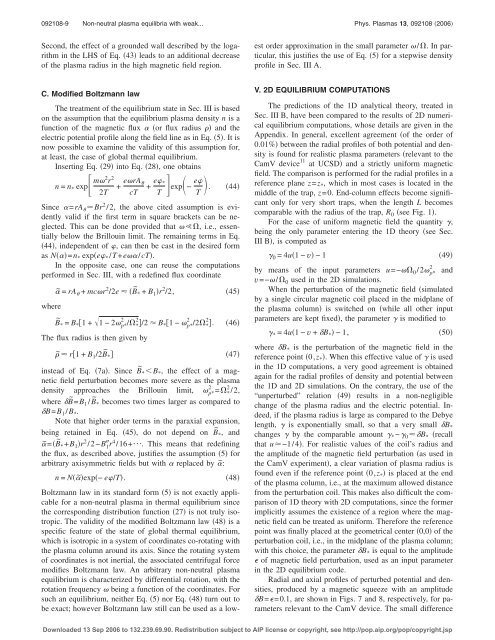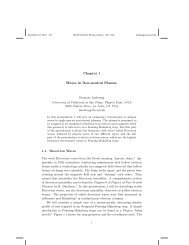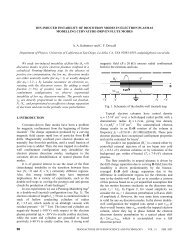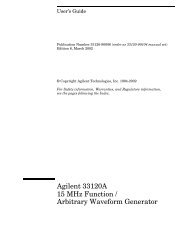Non-neutral plasma equilibria with weak axisymmetric magnetic ...
Non-neutral plasma equilibria with weak axisymmetric magnetic ...
Non-neutral plasma equilibria with weak axisymmetric magnetic ...
Create successful ePaper yourself
Turn your PDF publications into a flip-book with our unique Google optimized e-Paper software.
092108-9 <strong>Non</strong>-<strong>neutral</strong> <strong>plasma</strong> <strong>equilibria</strong> <strong>with</strong> <strong>weak</strong>... Phys. Plasmas 13, 092108 2006<br />
Second, the effect of a grounded wall described by the logarithm<br />
in the LHS of Eq. 43 leads to an additional decrease<br />
of the <strong>plasma</strong> radius in the high <strong>magnetic</strong> field region.<br />
Boltzmann law in its standard form 5 is not exactly applicable<br />
for a non-<strong>neutral</strong> <strong>plasma</strong> in thermal equilibrium since<br />
the corresponding distribution function 27 is not truly isotropic.<br />
The validity of the modified Boltzmann law 48 is a<br />
specific feature of the state of global thermal equilibrium,<br />
which is isotropic in a system of coordinates co-rotating <strong>with</strong><br />
the <strong>plasma</strong> column around its axis. Since the rotating system<br />
of coordinates is not inertial, the associated centrifugal force<br />
modifies Boltzmann law. An arbitrary non-<strong>neutral</strong> <strong>plasma</strong><br />
equilibrium is characterized by differential rotation, <strong>with</strong> the<br />
rotation frequency being a function of the coordinates. For<br />
such an equilibrium, neither Eq. 5 nor Eq. 48 turn out to<br />
be exact; however Boltzmann law still can be used as a lowest<br />
order approximation in the small parameter /. In particular,<br />
this justifies the use of Eq. 5 for a stepwise density<br />
profile in Sec. III A.<br />
C. Modified Boltzmann law<br />
The treatment of the equilibrium state in Sec. III is based<br />
on the assumption that the equilibrium <strong>plasma</strong> density n is a<br />
function of the <strong>magnetic</strong> flux or flux radius and the<br />
electric potential profile along the field line as in Eq. 5. Itis<br />
now possible to examine the validity of this assumption for,<br />
at least, the case of global thermal equilibrium.<br />
Inserting Eq. 29 into Eq. 28, one obtains<br />
n = n * exp m2 r 2<br />
2T<br />
+ erA <br />
cT + e *<br />
exp− e . 44<br />
T T<br />
Since =rA Br 2 /2, the above cited assumption is evidently<br />
valid if the first term in square brackets can be neglected.<br />
This can be done provided that , i.e., essentially<br />
below the Brillouin limit. The remaining terms in Eq.<br />
44, independent of , can then be cast in the desired form<br />
as N=n * expe * /T+e/cT.<br />
In the opposite case, one can reuse the computations<br />
performed in Sec. III, <strong>with</strong> a redefined flux coordinate<br />
where<br />
˜ = rA + mcr 2 /2e B˜ * + B 1 r 2 /2,<br />
45<br />
B˜ * = B * 1+ 2 1−2p* / 2 * /2 B * 1− 2 p* /2 2 * . 46<br />
The flux radius is then given by<br />
˜ r1+B 1 /2B˜ *<br />
47<br />
instead of Eq. 7a. Since B˜ *B * , the effect of a <strong>magnetic</strong><br />
field perturbation becomes more severe as the <strong>plasma</strong><br />
density approaches the Brillouin limit, 2 p* = 2 * /2,<br />
where B˜ =B 1 /B˜ * becomes two times larger as compared to<br />
B=B 1 /B * .<br />
Note that higher order terms in the paraxial expansion,<br />
being retained in Eq. 45, do not depend on B˜ *, and<br />
˜ =B˜ *+B 1 r 2 /2−B 1 r 4 /16+¯. This means that redefining<br />
the flux, as described above, justifies the assumption 5 for<br />
arbitrary <strong>axisymmetric</strong> fields but <strong>with</strong> replaced by ˜ :<br />
n = N˜ exp− e/T.<br />
48<br />
V. 2D EQUILIBRIUM COMPUTATIONS<br />
The predictions of the 1D analytical theory, treated in<br />
Sec. III B, have been compared to the results of 2D numerical<br />
equilibrium computations, whose details are given in the<br />
Appendix. In general, excellent agreement of the order of<br />
0.01% between the radial profiles of both potential and density<br />
is found for realistic <strong>plasma</strong> parameters relevant to the<br />
CamV device 11 at UCSD and a strictly uniform <strong>magnetic</strong><br />
field. The comparison is performed for the radial profiles in a<br />
reference plane z=z * , which in most cases is located in the<br />
middle of the trap, z=0. End-column effects become significant<br />
only for very short traps, when the length L becomes<br />
comparable <strong>with</strong> the radius of the trap, R 0 see Fig. 1.<br />
For the case of uniform <strong>magnetic</strong> field the quantity ,<br />
being the only parameter entering the 1D theory see Sec.<br />
III B, is computed as<br />
0 =4u1−v −1<br />
49<br />
2<br />
by means of the input parameters u=− 0 /2 p* and<br />
v=−/ 0 used in the 2D simulations.<br />
When the perturbation of the <strong>magnetic</strong> field simulated<br />
by a single circular <strong>magnetic</strong> coil placed in the midplane of<br />
the <strong>plasma</strong> column is switched on while all other input<br />
parameters are kept fixed, the parameter is modified to<br />
* =4u1−v + B * −1,<br />
50<br />
where B * is the perturbation of the <strong>magnetic</strong> field in the<br />
reference point 0,z * . When this effective value of is used<br />
in the 1D computations, a very good agreement is obtained<br />
again for the radial profiles of density and potential between<br />
the 1D and 2D simulations. On the contrary, the use of the<br />
“unperturbed” relation 49 results in a non-negligible<br />
change of the <strong>plasma</strong> radius and the electric potential. Indeed,<br />
if the <strong>plasma</strong> radius is large as compared to the Debye<br />
length, is exponentially small, so that a very small B *<br />
changes by the comparable amount * − 0 B * recall<br />
that u−1/4. For realistic values of the coil’s radius and<br />
the amplitude of the <strong>magnetic</strong> field perturbation as used in<br />
the CamV experiment, a clear variation of <strong>plasma</strong> radius is<br />
found even if the reference point 0,z * is placed at the end<br />
of the <strong>plasma</strong> column, i.e., at the maximum allowed distance<br />
from the perturbation coil. This makes also difficult the comparison<br />
of 1D theory <strong>with</strong> 2D computations, since the former<br />
implicitly assumes the existence of a region where the <strong>magnetic</strong><br />
field can be treated as uniform. Therefore the reference<br />
point was finally placed at the geometrical center 0,0 of the<br />
perturbation coil, i.e., in the midplane of the <strong>plasma</strong> column;<br />
<strong>with</strong> this choice, the parameter B * is equal to the amplitude<br />
of <strong>magnetic</strong> field perturbation, used as an input parameter<br />
in the 2D equilibrium code.<br />
Radial and axial profiles of perturbed potential and densities,<br />
produced by a <strong>magnetic</strong> squeeze <strong>with</strong> an amplitude<br />
B==0.1, are shown in Figs. 7 and 8, respectively, for parameters<br />
relevant to the CamV device. The small difference<br />
Downloaded 13 Sep 2006 to 132.239.69.90. Redistribution subject to AIP license or copyright, see http://pop.aip.org/pop/copyright.jsp








![WORKSHOP PARTICIPANTS LIST [pdf] - UC San Diego](https://img.yumpu.com/35298899/1/190x245/workshop-participants-list-pdf-uc-san-diego.jpg?quality=85)
